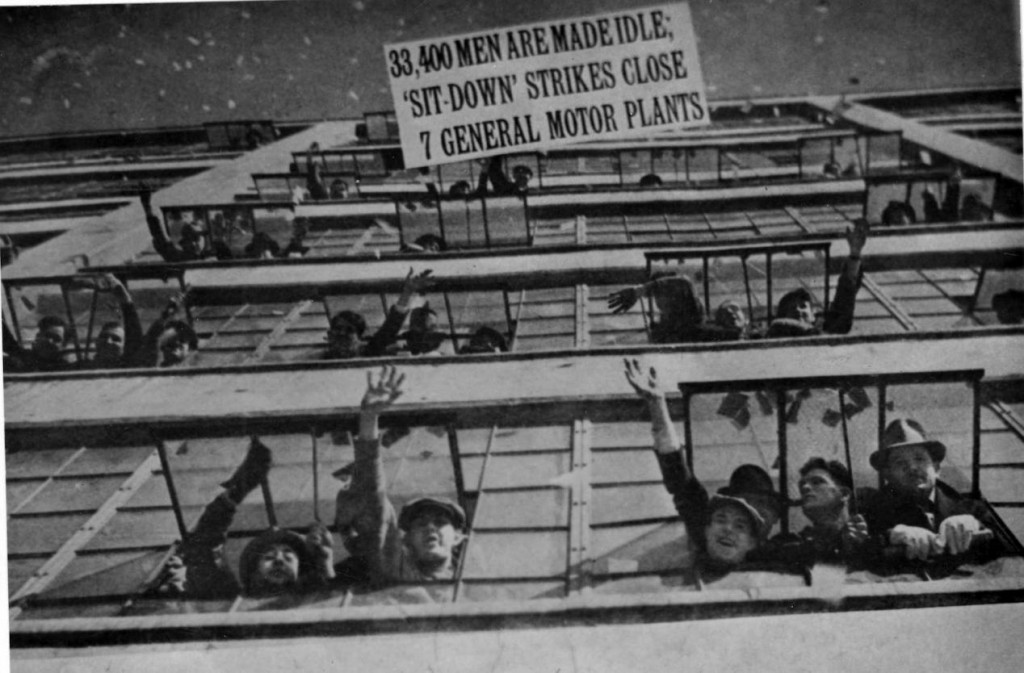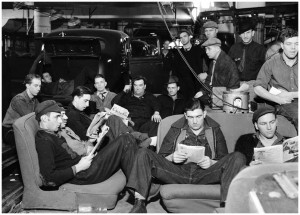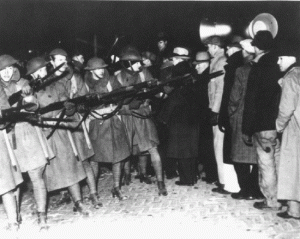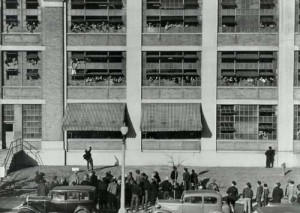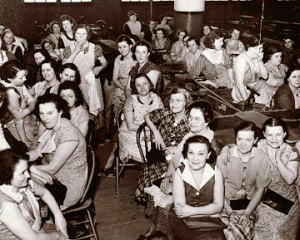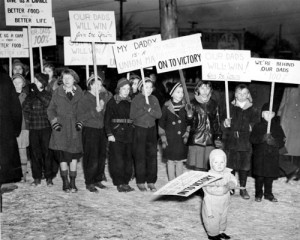http://www.sloanlongway.org/Sloanum.aspxMuse
On December 30, 1936, General Motors workers at Fisher Body No. 1 became part of what has been called the most significant strike in American labor history. These workers were fighting for recognition of their union, the United Auto Workers, and to keep their jobs from going to non-union workers. Other demands included a switch from piece work to hourly pay, a 30 hour week, ending “speed-up” production, and seniority rights.
Strikers decided that instead of picketing outside the building, they would sit inside the factory-preventing other people from working their jobs and stopping GM production. Inside the plant, men depended on wives, family members, and the public for support and food.
For a time, the strike was peaceful. President of GM, Alfred Sloan, did not even want to deal with the strikers. He wanted them to get out of the plant before dealing with them. This made it very difficult to arrange negotiations between the strikers and the company.
On January 11, 1937, police attempted to stop the delivery of food into the plant. Until this time, women and family members of the strikers had passed items to the strikers through factory windows. Car parts and water from fire hoses were launched at the police from inside the planet. Law enforcement fired buckshot and tear gas at the strikers. Fighting ended with strikers controlling the gates to the plant and with the police retreating.
Governor Frank Murphy sent in the National Guard to maintain peace and order, but refused to direct them to act with force against the workers.
It was not just Fisher Body No. 1 that was striking. Fisher No. 2, also in Flint, and plants in Atlanta, Kansas City, and Cleveland struck, too. All these UAW members were working towards the goal of GM recognizing the Union as a collective bargaining agent. This meant that the union workers wanted to be able to bargain with GM as a group and not as individuals.
By February 4, 1937, the strikers inside Fisher No. 1 had been living without heat or power for several weeks. Governor Murphy had persuaded GM to negotiate with strikers, but the strikers ignored court injunctions ordering them to leave the plant. More than 4,000 National Guardsmen and 1,000 citizens and policemen surrounded Fisher No. 1 and its strikers. The strikers reduced their demands to just one: GM recognition of the UAW as the sole bargaining agent for workers. On February 11, GM gave in and the strike ended.
Results
Sit-down strikes spread from the auto industry to other industries, such as laundries and cigar factories. Governor Murphy repeatedly urged negotiation and refused to use force to settle disputes. The Sit-Down Strike was ultimately successful and peacefully resolved because both sides compromised.
Flint Sit-Down Strike timeline
December 1936
December 29 – G.M. transfers union members out of the Chevrolet Fisher Body No. 2 plant.
December 30- 7:00am Chevrolet Fisher Body No. 2 plant workers start a sit-down strike. 8:00pm Buick Fisher Body workers start a sit-down strike. 8:00pm Buick Fisher Body No. 1 workers begin a sit-down strike.
January 1937
January 1 – Women’s Auxiliary established to aid sit-down strikers and their families.
January 2 – G.M. seeks injunction against workers. Genesee County Circuit Court Judge Black grants injunction.
January 3 – Judge Black found to own GM Stock, injunction overturned.
January 4 – U.A.W. presents contract demands to G.M.
January 7 – A pro-business organization known as the “Flint Alliance” begins anti-union activity.
January 11- Flint police and county sheriff deputies attempt to retake Chevrolet Fisher Body No. 2 and are repelled by workers, 27 are injured. The event becomes known as “Battle of the Running Bulls.”
January 12 – Governor Frank Murphy orders National Guard to Flint to prevent further violence. By strike’s end, 4,000 guardsmen are stationed in Flint.
January 20 – Women’s Emergency Brigade established “to protect our husbands and sons from violence”
January 27 – Flint Alliance holds “Back to Work” rally at I.M.A. Auditorium
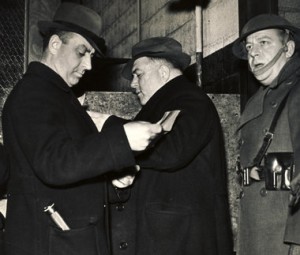
Genesee County Sheriff Thomas W. Wolcott, accompanied by Chief Deputy Gerald Ruddy, reads an injunction to sit-down strikers at General Motors’ Fisher Body plants. Genesee Circuit Judge Paul V. Gadola granted the injunction, ordering the strikers out of the plants, but the ignored it and the strike spread.
February 1937
February 1 – Genesee County Circuit Court Judge Gadola orders workers to leave plants and stop picketing. Sit-down strike spreads to Chevrolet Plant No. 4.
February 3 – Governor Murphy refuses to use National Guard to evict strikers from plants.
February 11 – 2:30am G.M. agrees to recognize the U.A.W.

